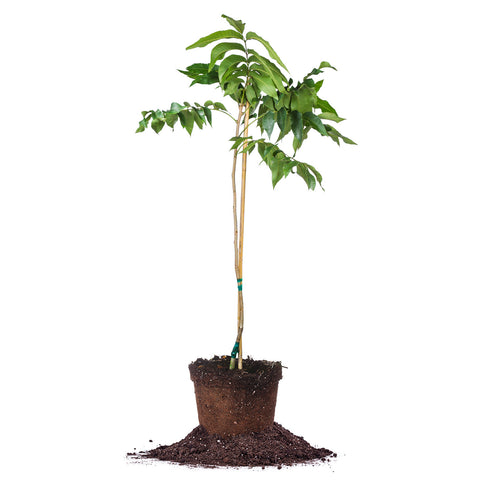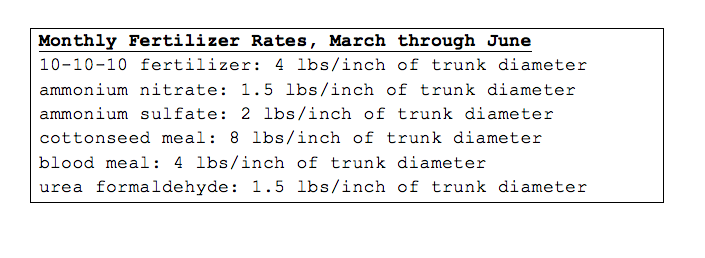PECAN GROW GUIDE: GO NUTS!
You CAN grow your own pecan trees. All you need is some land and commitment, and a bit of passion.
In this guide we'll explore everything you need to know about growing pecan trees at home.
Let's dive in!
Buy Pecan Trees Online






Pecan trees (carya illinoinensis) take 20 to 25 years to reach full maturity and get 60-100 feet tall, with a spread of 30-50 feet across. But don’t get discouraged yet: Pecan trees started from container grown stock (such as the ones Perfect Plants offers) will begin to produce nuts in as little as 4-8 years.
Many people ask us how do pecans grow? This grow guide will teach you everything you need to know about growing pecans.
Getting Started
Select at least two different varieties since fruit set is improved by cross-pollination. Perfect Plants offers no fewer than fourteen differen varieties of pecan trees for sale. We recommend choosing at least one each of Type 1 and Type 2 varieties. Type 1 pecan trees shed pollen first and their flowers are receptive of pollen later in the growing season. Conversely, type 2 pecan trees are receptive to pollen first. Their pecan tree catkins shed pollen later in the season through the wind.Choose a planting spot with full sun and plenty of room. Pecan trees get very large and their root systems run deep and wide, at least twice as wide as the canopy. Space pecan trees 65-80 feet apart, and be careful to stay away from buildings and other trees that could be damaged by falling limbs. They can be planted in most areas of the southeastern United States.
The soil at the planting site should be a well-drained soil with a rich sandy loam and at least 3-5 feet deep with a porous subsoil. Soil pH should be 6.0-7.0. They like neutral to slightly acidic soils. Pecan trees grown in such soils likely will not need any nutrient fertilizers except nitrogen and zinc. If in doubt, have the soil tested to determine what other nutrients you may need to add. If your soil is very dry or very sandy, you will have to irrigate more often. Zinc deficiency is common in some trees.
Pecan tree growth rate is very fast. Some trees can gain up to 3-5 feet per year. Choose a site where your tree will be able to stay for many years to come.
Planting Pecan Trees
Plant pecan trees when they are dormant, in late winter or early spring. Thoroughly water the little pecan tree in its container before starting. Remove the tree from the container and straighten out the taproot if necessary. Spread out the other roots, trimming if needed. Dig a hole as deep as the taproot and wide enough to accommodate the other roots spread out. Do not add fertilizer or soil amendments.
Place the tree in the hole without damaging the fragile taproot, and spread out the side roots. Next, fill the hole 3/4 deep with water. Backfill soil as the water is running until the hole is full. (The water helps to prevent air pockets around the roots.) Be sure to keep the tree at the same depth it was in the container. Don’t pack the soil too hard.
Spread a layer of organic mulch over the root zone to help hold moisture in and keep the weeds away. Cut off about 1/3 of the top of the tree to encourage the tree to spend more of its energy growing roots, instead of keeping the top alive.
The little tree will need protection from sun scald and nibbling rodents. Paint the trunk with a white latex paint or use a sleeve-like growing tube for the first three years.
How Many Pecan Trees Should You Plant Per Acre?
Pecan Tree Care
Did we say growing pecan trees requires commitment? Keeping up with the maintenance and care for pecan trees ensures that your tree will thrive and be healthy for many years to come. Properly fertilized and pruned trees will exhibit the best nut production and will live to be huge, beautiful nut trees.How to Fertilize Pecan Trees

Large trees should be treated with an NZn or zinc sulfate foliar spray every 2-4 weeks starting at bud break in March until June. (Applying fertilizer can get difficult as the tree gets taller.) If the newly planted tree is growing well by midsummer, apply a half pound of ammonium nitrogen based fertilizer about a foot from the trunk. If it hasn’t grown at least a foot taller, don’t fertilize until the second year.
Beginning in the second year and continuing for 15 years, apply a small amount of nitrogen fertilizer each month from March through June. See notes below for rates of various fertilizers. After 15 years, fertilize only in March and again in May. Broadcast the pecan tree fertilizer evenly out to the drip line and a little beyond, but do not place it within 10 inches of the trunk diameter.
Alternatively, use one of the commercial pecan fertilizers that combine zinc and nitrogen, according to label directions.
Your young pecan tree will need about an inch of rain or 15-25 gallons of water, per week. Mature pecan trees need 1-2 inches of rain per week, especially during the heat of summer. If rainfall is insufficient, you will have to irrigate, preferably with a drip system. See sidebar for rates of supplemental watering.
Pruning Pecan Trees

Pecan trees should be trained to a central leader with surrounding branches (the scaffold branches) spiraling outward and upward. Pruning should be done in late winter or early spring while the trees are dormant and before the active growing season. Start training as young trees. Avoid summer pruning as this is when pecan nuts are being formed. The pruning site should be clean-cut to stay free of insects and diseases such as pecan phylloxera.
Here are some tips for training your tree. Retain side branches that come off the central leader at an angle of around 45 degrees, and remove those that come off more horizontally outward or more sharply upward. The scaffold branches should be tip-pruned to encourage branching. Eventually, the lowest scaffold branches should be 6-8 feet above ground, and evenly spaced around the tree. This may take 5-10 years of annual pruning.
Pecan trees tend to exhibit alternate bearing. This means they will produce a heavy crop of pecan nuts one year and one of less pecan production the next. This is one of the many challenges for pecan growers. Annual fertilization and pruning will help to alleviate this problem.

Bareroot Pecans
Pecan trees are most commonly planted as bare-root transplants. This means that they are dug from the ground while they are dormant and have had the soil shaken off to expose the root. Bare-root trees should be transplanted between December and March while dormant which helps with transplant shock and less transpiration (water loss) immediately after planting.
Bare-root pecan trees have long taproots and require a deep planting hole. In most situations, the hole should be at least three feet deep and 12 to 24 inches wide so that all side roots can be properly positioned as the hole is refilled. It is best to plant them as soon as possible.
Allow your tree’s roots to soak in water for 1-2 hours before planting. Spread out the roots to encourage outward growth. Refill the hole with native soil (what was removed at the time of digging). Gently release any air pockets. The last step is to thoroughly water.
Harvesting Your Pecans
Sound pecan nuts should be a pale brown with intact shells; if the brown husk hasn’t already detached from the nut. If it doesn’t crack open easily, or if the husk is green, the nut inside is probably not mature. If the husk is black, the nut is most likely rotten.
Once your trees have started dropping nuts, you can speed up the harvest by shaking the tree and whacking them with long poles. If you’re picking up pecans by hand, they will be easier to see and pick up if you spread a sheet or tarp out underneath the tree.
Pecan Picker Uppers
A pecan picker-upper or a mechanical harvester can make it even easier and saves time. One type of pecan picker is comprised of a funnel shaped wire spring on the end of a four foot handle and when you press down on a nut, it spreads open, allowing the nut to slip between the wires and into the contraption.
Mechanical harvesters include hand operated models that are pushed over the ground like an old fashioned reel lawn mower. The big commercial orchards use tractor powered mechanical tree shakers and pull-behind pecan harvesters that look like hay rakes.
Pecan nuts will drop continuously for a couple weeks or more, so check frequently in order to make sure the squirrels and deer don’t get to them first.
Storing Pecans
Once the nuts are dried you can store them in their shells for several months in a cool, dry place at room temperature. Shelled pecans (the kernels) can be stored in air tight containers or zip lock bags for up to six months in the fridge, and two or more years in the freezer. They have a longer shelf life in the refrigerator or freezer if stored properly. The air tight container is important so the shell nuts do not absorb odors or moisture content.
Good luck with your new pecan trees! And remember, the County Cooperative Extension office is your friend!

























